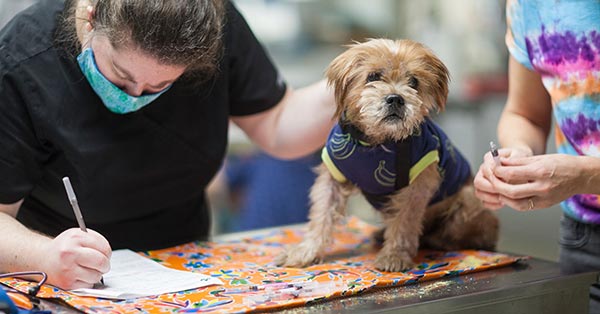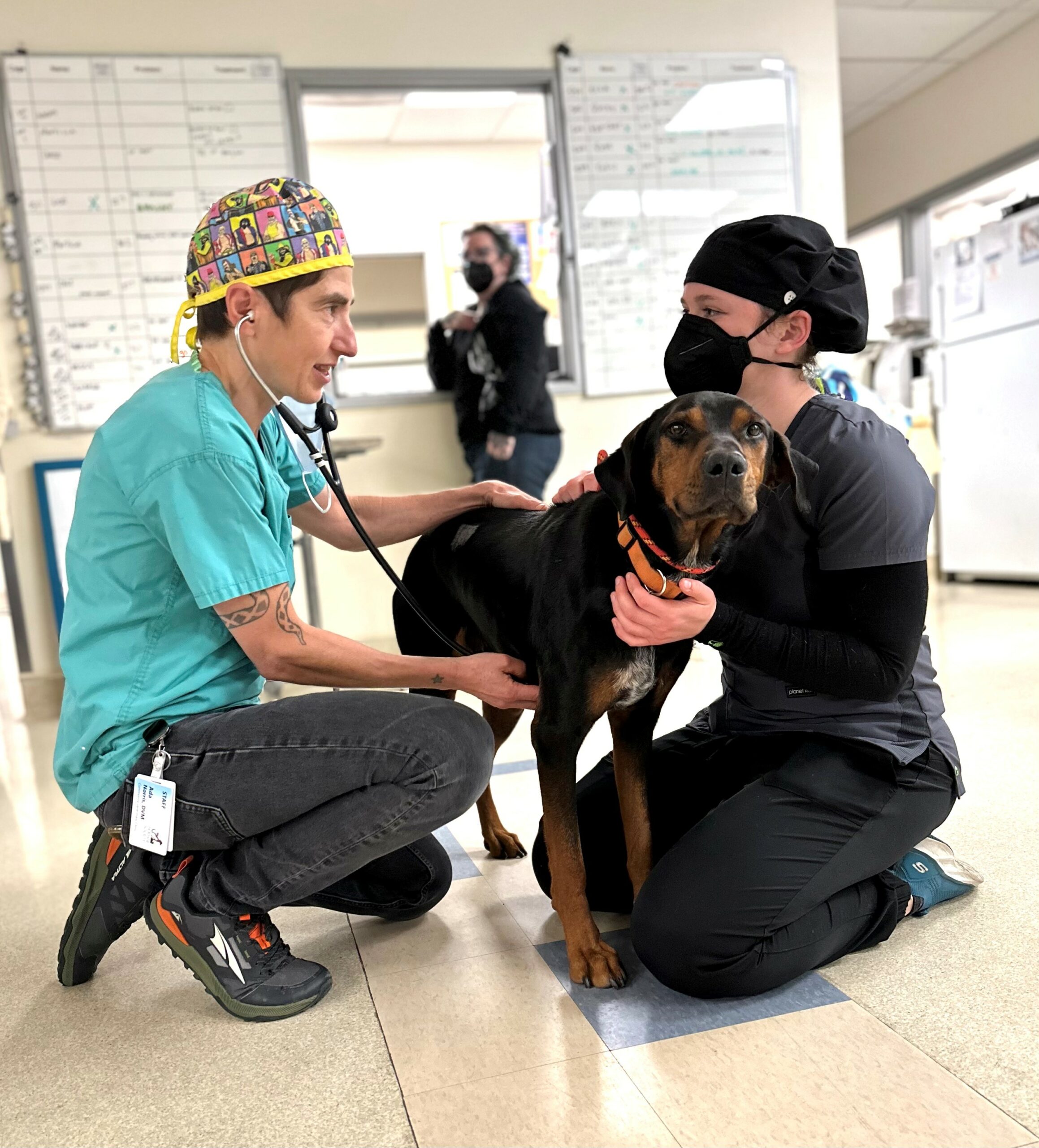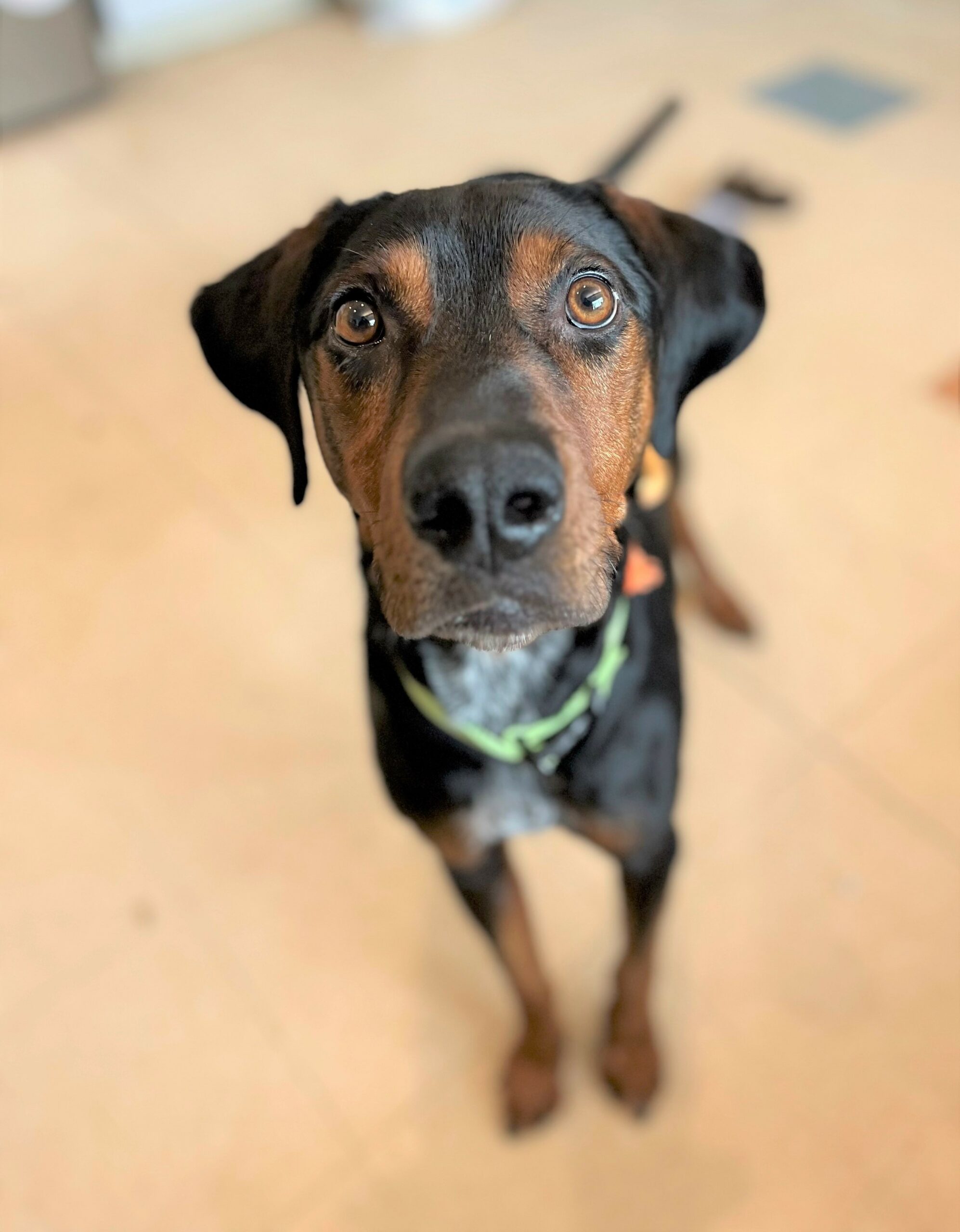Shelter Medicine
Shelter Medicine is a growing field of veterinary medicine dedicated to the care of homeless animals in shelters. With a focus on disease prevention, physical and behavioral wellness, and helping to make the animals in our care adoptable, HSSC’s Shelter Medicine team treats a variety of medical needs. From routine preventative care to comprehensive medical work-ups, surgery, and dentistry, we strive to provide the highest quality medical care possible.
Your donations to our Angels Fund support life saving procedures for the animals in our care. We take in many injured and health compromised animals from over-crowded shelters because of our surgery capabilities, allowing us to save animals who would otherwise have been euthanized. Thank you for your support of these vital procedures which ensure healthy, happy outcomes for animals in need.
Our Mission
An important goal of ours is to provide medical care that minimizes the overall length of stay of our entire animal population. This means preventing illness, working alongside our behavior team, containing infectious disease outbreaks quickly, providing support to foster parents, and working closely with adopters so they are able to take over the care of animals who have manageable conditions.
Although we work hard and our days can be long, it is rewarding to know that the efforts of our team truly make a difference for the animals in our care.
Who We Are
Our shelter medicine team consists of three veterinarians, four registered veterinary technicians (RVTs), eight veterinary assistants, and dozens of dedicated volunteers. Shelter medicine staff work closely with animal care, foster, intake & admissions, behavior, and adoptions staff to provide coordinated care to the animals housed at our two shelter locations and in foster care.
What we do
The shelter medicine team stays busy seven days a week, 365 days a year, caring for our shelter population. They begin each day with “shelter rounds” where they check on every animal housed at the shelter to ensure they have what they need and to monitor any ongoing health concerns. Over the course of the day, they perform physical exams, run diagnostics, provide medical treatments, and follow up on existing medical issues. The DVMs perform surgery and sedated procedures, and support staff perform dentals, x-rays, and assist in surgery.
Shelter Medicine Happy Tails
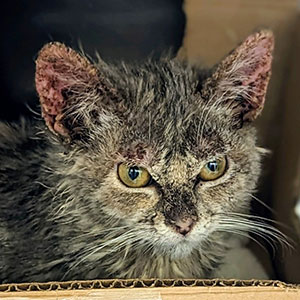
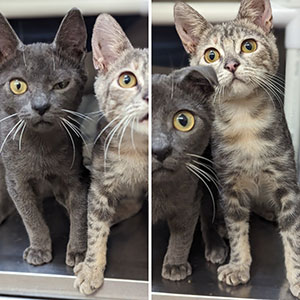
Link and Zelda
Today, we want to share a heartwarming success story about two adorable furballs, Link and Zelda, who overcame the challenges of ringworm and found their forever homes.
Ringworm, a contagious fungal infection, is particularly common in young kittens with developing immune systems. At HSSC, we take the health of our furry friends seriously, so all cats and kittens are thoroughly screened for ringworm upon arrival. Hair loss and crusty lesions are carefully examined under a wood’s lamp, which emits a bright apple green fluorescence when ringworm is detected. When a furry friend is diagnosed with ringworm, they receive specialized care in a quarantine ward, where they are joined by other animals battling the infection. Our dedicated staff, donning disposable protective gear, provide them with the tender care they need throughout their treatment journey.
The treatment for ringworm is a two-fold approach. First, our adorable patients get twice weekly lime sulfur dips to help eliminate the fungus. Second, they receive daily oral antifungal medication to combat the infection from within. This treatment typically lasts several weeks.
But that’s not all – these resilient sweethearts were also born with cerebellar hypoplasia (CH), a non-contagious and non-painful condition that impacts their movement and balance. Despite the challenges, they’re embracing life with joy and love.
Let’s hear it for these troopers! We’re dedicated to celebrating heartwarming success stories like Link and Zelda. Whether you choose to foster, donate, or adopt, you’re making a significant, positive impact on the lives of these animals, and for that, we extend our heartfelt thanks to you!
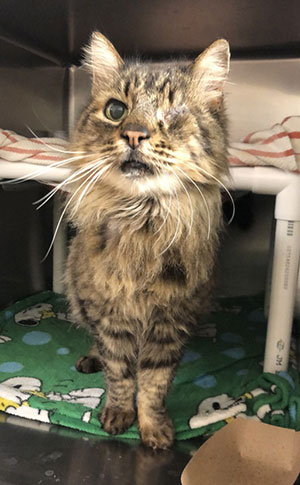
From “on the list” to home at last – Calcifer’s journey to adoption
You know that saying “when you adopt an animal you’re actually saving two lives – the animal you adopt and the one who gets that space at the shelter?” At a time when more animals are entering shelters than leaving them, this phrase takes on an even more urgent tone for animals like Calcifer. The affectionate grey tabby came to us, along with several other cats from a crowded Central Valley shelter where they were on the euthanasia list due to medical conditions.
Our dedicated, hardworking rescue partners have been operating at maximum capacity this past year and facing the toughest decisions over capacity. We’ve been working with them to take in as many animals as we possibly can each week. With kitten season in full swing and summer adoption slowdown ahead, we expect these heartbreaking pleas will continue for the foreseeable future.
We don’t know what Calcifer’s life was like before he entered the shelter system. We DO know he was one of the cuddliest cats we’d ever met! At an estimated 12 years old, he was very thin when he arrived at HSSC in April. He had a missing left eye, dirty ears and scabs around his face and neck. Our veterinary team gave him fluids, cleaned and treated his ears and wounds, and ran some bloodwork.
Through it all, Calcifer purred like a pro. He made it clear that his number one priority in life was to be in the company of kind humans. One of our cat care volunteers said that Calicifer was “the scruffiest cat at the shelter and the most loving.” When she was leaving his room, he stood on his hind legs and placed his front legs over her shoulders!
Calcifer’s senior blood panel came back normal but he did test positive for FIV, a disease that is primarily spread from cat to cat through fighting and bite wounds. Cats with FIV can live full lives without any symptoms of the disease, but we were concerned about his wounds that were slow to heal. Our veterinary team determined they were ulcerated skin masses that needed to be surgically removed. A biopsy showed that the masses were a type of skin cancer but they’d been completely excised. Dr. Kat Menard, HSSC Chief Veterinarian, Shelter Medicine, said the results could indicate Bowen’s disease, which can cause slow-growing lesions in older cats. The good news is that “they tend not to greatly impact a cat’s daily quality of life” and “they don’t typically spread to other organs”, Dr. Kat tells us. And, there are treatment options available should Calcifer need them later in life.
We are pleased to share that Calcifer recently left our shelter in the arms of a kind human committed monitoring his wellbeing, and giving him all the snuggles and togetherness he craves!
THANK YOU!
We are so grateful to be a part of a community that overflows with compassion for animals. From adopters so willing to love unconditionally and “save two lives”, to our rescue partners working tirelessly to provide positive paths for animals when space and resources are maxed out – and YOU. Your support enables us to remain nimble in responding to these urgent pleas and save lives!
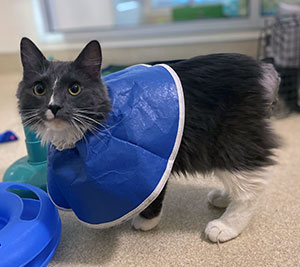
Highway To The Home-Zone!
Highway was found as an injured stray in Healdsburg. His tail was broken and partially degloved. This poor kitty had been through a lot, and his injuries needed immediate attention. He was transferred to our Santa Rosa shelter where our Medical team performed an amputation on his tail. We named him Highway in honor of a former shelter cat named Freeway with similar injuries. Highway was a very good patient and he recovered well. His affectionate nature and adorable fluffy looks made him irresistible, so it was no surprise that he was adopted quickly! We’re so very thankful to our outstanding Shelter Medicine team for helping Highway heal and thrive, and to our amazing Adoption team for helping him find a forever home.
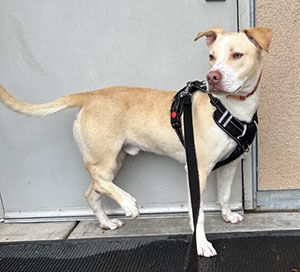
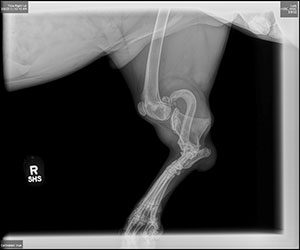
LUDO
An urgent plea came down the pipeline from our partner shelter in Stanislaus, they were frantically searching for another shelter to rescue Ludo. He was scheduled for a 4:30pm euthanasia that very day, and HSSC was his last resort. The subject line in their email wrote “Last Call ???? LUDO perfect boy! ????” , when our Admissions team responded with an enthusiastic “Yes we will take him!”, the email thread filled with tears and gratitude.
Ludo is a special dog with a deformed right hind leg. When he arrived at HSSC, our shelter medicine team worked to determine exactly what was going on with it. They noted that his tibia and fibula were abnormally short and that he either had a very well developed double dew claw or perhaps an additional toe! They also found that he had a fractured tooth, so when Ludo was getting his neuter surgery, they extracted his broken tooth and took radiographs of his leg.
Our team spent some time assessing his mobility and decided that he should keep his limb since he does occasionally use it to help with balance, and it isn’t getting in his way. We’re very happy this sweet dog could avoid such a daunting surgery. Ludo’s leg doesn’t slow him down one bit, he’s always very happy and active. He zooms around our play yards and has made a ton of friends with staff and volunteers! We’re so excited to have helped this happy dude find the loving home he so deserves!

DOTHRAKI
The capacity crisis that shelters across the country have been experiencing in the past year shows no sign of letting up. Here at HSSC, we continue to work with our North Bay rescue partners when they are facing tough decisions about higher-risk animals – including those with treatable medical issues – due to lack of space. Your support is literally helping us save these precious lives!
Last year, our shelter hospital provided veterinary care for over 1,000 homeless animals on their path to adoption. This year, the volume of shelter animals in need continues to grow. We are saving animals like Dothraki, a 5-year-old cat who was at risk of euthanasia at a very crowded, overwhelmed Central Valley shelter because of his acute medical condition. One of his eyes was abnormally large and infected, and required enucleation (eye removal) surgery in order for him to live a healthy, comfortable life. He was transferred to us just in time this past March, along with several other cats and a dog who were also scheduled for euthanasia.
In spite of the pain his eye was causing him, Dothraki was snuggly and affectionate from the moment he arrived. His life clearly revolved around people! His surgery and recovery went well and, in no time flat, he found a home where he will be snuggled and loved forever.
We continue to take in multiple urgent transfers each week. Thank you for helping us serve as a beacon of hope for animals in need of second chances.

COLT
Colt is a little groggy. He’s just coming out of sedation and seeking snuggles from our veterinary team, who are only too happy to oblige. The handsome hound mix has completely melted our hearts, but it’s actually his heart we’re keeping an eye on.
Colt has Heartworm, a disease that is spread to dogs through mosquitos. When an infected mosquito bites a dog, it leaves behind infective larvae, which mature into adult heartworms. (At this point, we could show you a picture of some infective heartworms, but we’d much rather show you more pictures of Colt’s beautiful sweet face!)
Compared to dogs, cats are somewhat resistant to infection, but it can still occur. These parasites can cause heart failure, lung disease and damage to other organs as well. Not only can Heartworm be life threatening to animals, treatment requires a series of sedated injections and oral medications over several months, as well as re-tests and extremely limited activity.
Heartworm treatment is lengthy, complicated and risky. Thankfully though, preventing it is much easier! According to the Marin/Sonoma Mosquito & Vector Control Abatement District, dogs are typically at highest risk of acquiring the disease from May through August. This means NOW is the perfect time to talk to your vet about the best method of prevention based on your pet’s risk factors and lifestyle.
We began Colt’s treatments when he first came to us from a partner shelter and, now that he has been adopted, we’ll continue to work with his new family for the duration of his treatments. We are grateful to his family for providing a safe, loving home where he can continue to heal and look forward to a lifetime of snuggles and fun times ahead.
KODAK
Life is full of surprises. You never know who you are going to meet or who will change your life forever.
We don’t know what early puppyhood was like for Moose (now Kodak). We can only imagine his days were full of stress and uncertainty. We do know the moment when everything changed for the better: the day a caring stranger found him running loose in a local park – scared and vulnerable – and brought him to safety at HSSC.
His finder was visiting from out of town, but he asked us to contact him if we had any problems finding a forever home for the growing shepherd pup. One look into those expressive brown eyes and we didn’t think we’d have any trouble!
Our intake team set about giving Kodak his first exam. He was covered with ticks; they pulled them from all over his body and ears. He also had an umbilical hernia roughly the size of a tennis ball – a common congenital condition that we could correct with routine surgery at the time of his neuter procedure, if no one came to claim him before then.
No one ever did claim him, but that doesn’t mean he waited out his “stray hold” alone! Like every animal in our care, he received lots of TLC and companionship as we nurtured him along on his journey. To ensure he received copious amounts of socialization, he spent a week with one of our canine foster volunteers until it was time for his surgery.
A lifesaving pivot
Kodak’s surgery day arrived and brought with it a major surprise. After his neuter procedure, our Director of Veterinary Services, Lisa Labrecque, DVM, proceeded with surgery to correct his hernia. “As soon as I made an incision over the umbilical hernia and then into his abdomen, I immediately felt and heard a rush of air, which can only be explained by air coming from the chest or lungs. That was my first clue that something more complicated was going on,” Dr. Lisa tells us. “I followed the herniated tissue to the diaphragm and saw that it was going through it. I gently retracted the tissue and, to my surprise, the gall bladder followed and then a liver lobe!”
Kodak’s abdominal organs had herniated through his diaphragm into his chest cavity. Without the diaphragm intact, Dr. Lisa knew he would not be able to breathe on his own and she had to think fast. She had her technician “breathe” for him by squeezing a reservoir bag on the anesthesia machine to inflate Kodak’s lungs every 8 – 10 seconds. She brought another staff veterinarian over to assist in positioning him, so that Dr. Lisa could see his full diaphragm and repair the opening.
Dr. Lisa believes Kodak had “a rare peritoneopericardial diaphragmatic hernia (PPDH), where the abdominal contents move into the pericardial sac, which encloses the heart.” On his post-operation x-rays, she could see a significant amount of air in his pericardial sac, “suggesting there was communication between the lungs and the pericardial sac.”
The intense surgery was complete. Dr. Lisa and her team monitored Kodak extremely closely to make sure he could breathe on his own while they waited for his body to reabsorb “all the extra air that shouldn’t have been in his chest and pericardial sac.”
Thanks to their well-honed skills and cool-headedness, Kodak’s surgery was a success! He remained under veterinary care for a few days so his healing could be closely monitored. He recovered with flying colors and, if his love of belly rubs was any indication, we knew he was ready to find a home where he could be loved forever!
Chance meetings
Perhaps the biggest surprise of all came to Kodak’s adopter, Crystal – she didn’t think she wanted to adopt a dog. Her cousin was fostering him and Crystal wanted to show her children “that puppies are not just cute but a lot of work, and it backfired! He was super calm and had a great temperament!”
Now that Kodak is officially a member of Crystal’s family, he is living a life full of love and “Kodak moments” – including his first visit to the snow, camping trips, volleyball tournaments (he’s the team’s mascot!) and “just chilling” with his family. “We take him everywhere,” Crystal shares. He recently graduated from HSSC’s KinderPuppy class where, as the biggest puppy in the class, he made new dog friends of all shapes and sizes. One of his teachers, HSSC’s Canine Behavior Program Manager, Lynnette Smith, says Kodak is “huge, mellow and very food motivated!” How huge? His family did a DNA test and learned that he is 86% German Shepherd and 13.6% Saint Bernhard!
Thank you!
Each animal’s journey is unique. Some require intensive behavior support to heal emotionally. Some – like Kodak – require specialized medical care to go on to live healthy lives. But each one carries with them all the loving connections they’ve made along the way. You make this possible and we are so grateful. From quick-thinking strangers to our dedicated foster volunteers and angel donors – our compassionate community fuels our lifesaving work and changes the animals’ lives forever!
TWIST
Twist is part acrobat, part purr machine and 100% kitten! He deftly chases his wand toy, stops to solicit cheek scritches, then commences with his playful leaps and pirouettes. At five months old, he’s a pre-teen” kitten who views the world with confidence and wide-eyed curiosity. And, thanks to your compassion, his world is a whole lot brighter!
Twist was in a vulnerable state and quickly running out of options before coming to HSSC this past September. At his previous shelter, he presented with a condition sometimes known as Orphaned Kitten Prepuce Syndrome. This occurs when orphaned kittens, in absence of a mama, mistakenly nurse on their siblings’ genitals. This can lead to scarring and eventually cause damage and obstruction to the urethral opening. This sets the animal up for painful urinary infections and life-threatening blockages but can be remedied with surgery.
Unfortunately, surgery was not an option at Twist’s previous shelter. They were overcrowded and faced with making the hardest, most heartbreaking decisions: Twist and several other kittens with medical issues (including eight with ringworm) would be euthanized unless they could find placement elsewhere. Thankfully, we were able to make room and take them all in.
Our veterinary team went for the least invasive route for Twist – a surgery called Preputial Urethrostomy. HSSC DVM Ada Norris describes the procedure as an attempt “to salvage the anatomy and create a functional urinary system.” His condition was so severe, however, that he ultimately needed a second, full Perineal Urethrostomy surgery. The surgery was a success. Twist is healing well and will soon be available for adoption. “He’s the happiest little kitten and seems grateful for all our interventions,” Dr. Ada says.
This year, we’ve taken in a high volume of kittens and cats infected with ringworm who had nowhere else to turn. This highly contagious fungus requires lengthy treatment times and strict isolation protocols – resources that are beyond the means of many of our partner rescues. Sometimes these kittens suffer from severe upper respiratory infections, which need to be treated at the same time. At our highest point this summer, we had four full isolation wards between our Santa Rosa and Healdsburg shelters!
What enables us to expand our capacity to take in the most vulnerable animals?
The compassion and coordination of many, including:
Our Beloved Volunteers
Our staff is grateful for our dedicated volunteers who spend several hours a day assisting with dip treatments and socializing of infected cats to help them feel comfortable and loved.
As Saffron Williams, HSSC Feline Behavior Program Manager, explains, “cats who are undergoing treatment for ringworm could, if only given attention during medication, form a negative association with humans. Having consistent visitors who will play with them, sit with them while they eat, and pet and otherwise handle them, ensures that they will have positive experiences with people.”
Mary, one of these special volunteers, goes the extra mile and creates disposable toys by hand from recycled materials. While these kitties are living in isolated wards for weeks at a time, Mary and her kicker toys give them much needed enrichment. Our foster volunteers are another reason we are able to save animals when they need us most. They open their homes to animals recovering from illness or surgery – or baby animals not yet ready for adoption – so that we have space to care for more animals in our shelters. HSSC Foster Program Manager Nicole Gonzales is currently seeking fosters to help with some of our most sensitive groups – bottle baby kittens and those with infectious diseases, like ringworm. “Ringworm fostering requires a dedicated space for the animals that can be easily disinfected,” she explains. “A spare bathroom or bedroom with tile flooring works well.” Foster parents wear personal protective equipment, and we provide all materials and trainings necessary.
Get started on your volunteer journey here: humanesocietysoco.org/get-involved/volunteer-faq
Our Regional Rescue Partners
Shelters across the country have been dealing with an unprecedented overcrowding this year and our area is no different. We salute our North Bay rescue partners who collaborate with us to provide
lifesaving pathways for at-risk animals. At a time when our industry continues to face staffing shortages and other complex challenges, their passion and hard work keeps us moving
forward with strength and hope. We are all in this together!
Our Compassionate Donors
Your commitment to the animals enables us to be nimble and responsive when fellow shelters across California reach out to us and precious lives are at stake. While our industry continues to navigate challenging times, you are truly making a lifesaving difference – you make it possible for us to answer these calls for help. Your compassionate contributions to our Angels Fund go directly toward medical care for animals in need on their path to adoption. Thank you for making our community a safe place for animals to thrive through your loving support.
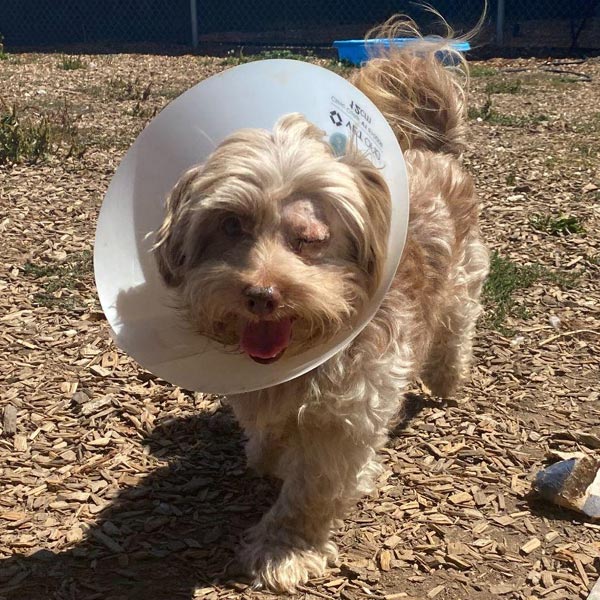
Frozen is a cute 7 year old Lhasa Apso mix who was transferred to us from a partner shelter in Sacramento. He arrived needing a neuter and surgical removal, or enucleation, of one of his eyes. This little scruffernutter was a great patient for our medical team and, as he healed from surgery, Frozen quickly became a volunteer and staff favorite for his friendly, happy-go-lucky nature. It’s no surprise that this adorable little guy was quickly adopted within 2 weeks of his arrival! We’re so happy we could help him on his path to health and home.
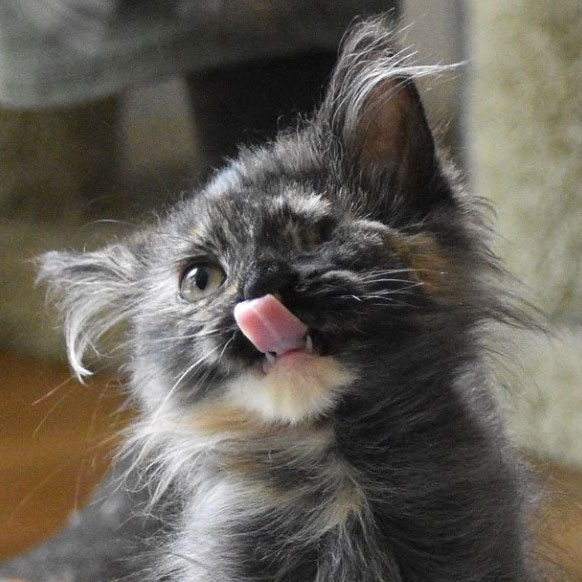
Pinwheel came to HSSC as a stray, she was found near some grape fields in Geyserville. Weighing less than a pound this poor baby was covered in fleas and mites and had a terrible upper respiratory infection that spread to her left eye which caused it to rupture. She was by far too small for surgery, so our Shelter Medicine team started her on antibiotics and pain medication to keep her comfortable while she grew.
She was immediately placed into foster care. Two of our staff members shared responsibilities taking this sweet girl home to feed her and keep her wounds clean. They named her Pinwheel. After a few weeks of loving care, she was big enough to have the surgery to ennoculate her eye. Little Pinwheel recovered well and was adopted by one of her foster parents who also works on our Shelter Medicine Team!
Pinwheel is now named Penny and she’s living very happily with her new family which includes her new best friend, another HSSC Alum cat named Nolan, who loves her, grooms her, and is by her side every day!
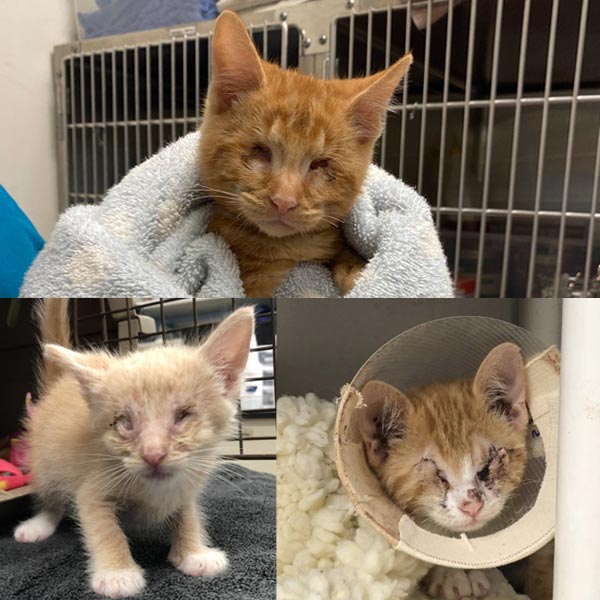
This trio of kittens came in with severe conjunctivitis. We started them on treatment and as the swelling and discharge started to resolve it became apparent that their eyeballs were abnormal. Two of the kittens (the two lighter buff colored ones) have a condition called microphthalmia which means that their eyes are smaller than normal and may not be properly developed. In the case of these two kittens their eyes were so small it’s hard to tell if they have eyes at all and are likely blind or have very impaired vision. The third kitten’s eyes were enlarged (buphthalmos) and his corneas had some chronic changes so we did a bilateral enucleation or surgical removal of both his eyes at time of neuter. They recovered well from surgery and were quickly adopted.
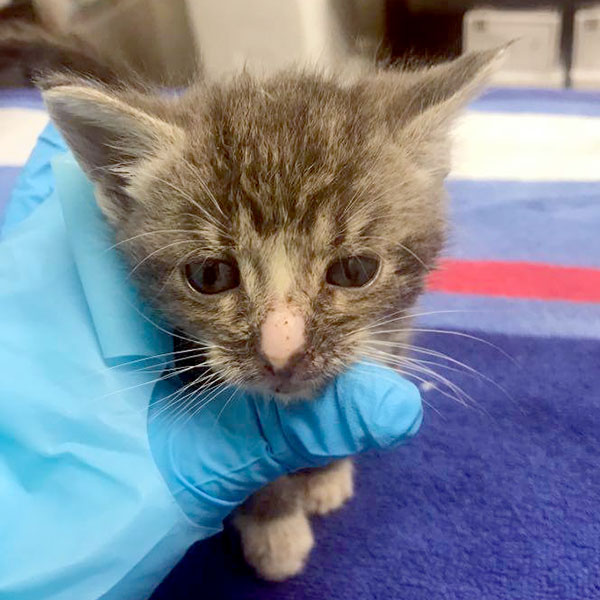
Pony Boy became a favorite of the shelter medical staff after many hours caring for him. As a very young kitten, he experienced trauma to his genital area that affected his ability to urinate. He went out to a loving foster family for close monitoring until he was old enough for anesthesia. When he was ready, our shelter medicine team performed surgery to widen the opening of his prepuce so he could urinate with greater ease. Following surgery, he was gifted with a snazzy vest called a Suitical that helped him with his healing process. He was the most fashionable cat at the shelter! Pony Boy recovered well from his surgery and we were all very happy to see the playful, loving, older kitten he had become! Once he was officially cleared for adoption, Pony Boy was quickly scooped up by a new, loving family. We couldn’t be happier for this sweet boy.
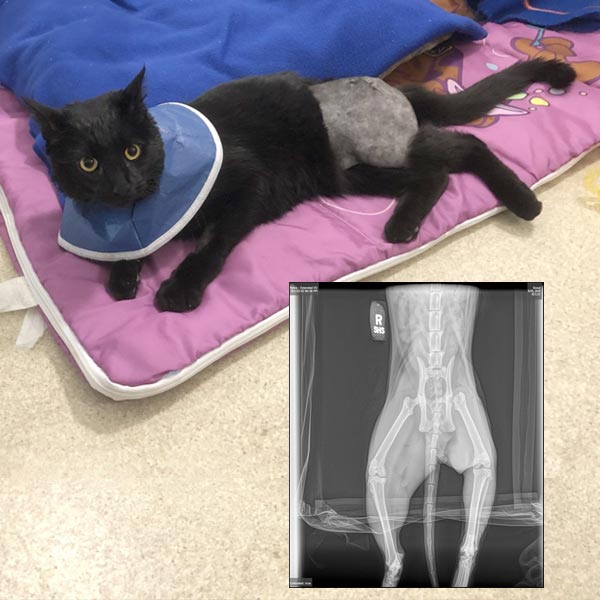
Scout came to us with a broken hip that required a surgical procedure known as a femoral head ostectomy (or FHO) to fix. In this procedure the head of the femur is surgically removed, and fibrous scar tissue forms to stabilize the joint. This is a not uncommon surgery that can help an animal regain comfort and mobility. During the initial recovery period he will receive physical therapy by our staff to help him regain strength and mobility.
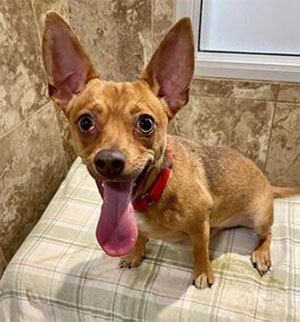
Braxton had a cherry eye, also known as a prolapsed nictitating membrane or prolapsed tear gland, in the right eye. Dogs have an extra tear gland in the lower lid that will occasionally prolapse, or pop out, appearing above the lid margin as a little red bleb. This can occur due to trauma, but some breeds are predisposed and in these breeds it can happen spontaneously. Breeds commonly affected include cocker spaniels, bulldogs, Boston terriers, beagles, bloodhounds, Lhasa Apsos, and Shih Tzus. Cherry eyes are problematic because this gland produces up to fifty percent of the watery portion of the tear film. Without sufficient tear production dogs can develop “dry eye,” which may lead to impaired vision. Surgical correction of the prolapse is the recommended treatment if the cherry eye is causing a problem though sometimes the repair can fail especially in those breeds that are predisposed.
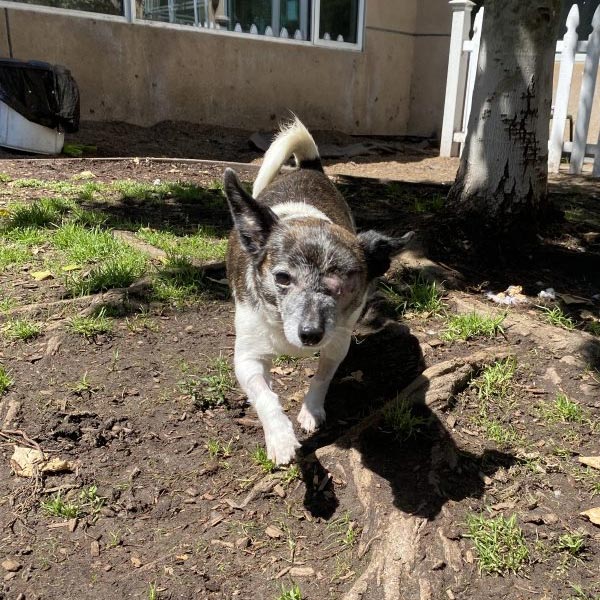
Moira the sweet little chihuahua came to us needing one of her eyes removed along with some small mammary masses at the time of her spay. It turned out that she was heartworm positive as well. She did great during surgery and during treatment for her heartworm. Heartworm is a worm like parasite that is transmitted by mosquitoes and lives within an animal’s bloodstream (most specifically the right side of their heart). Treatment for heartworm consists of several components spread out over a number of months so we make them available and continue the treatment post adopt. Happily, Moira has made a full recovery, and has been adopted into a loving home.
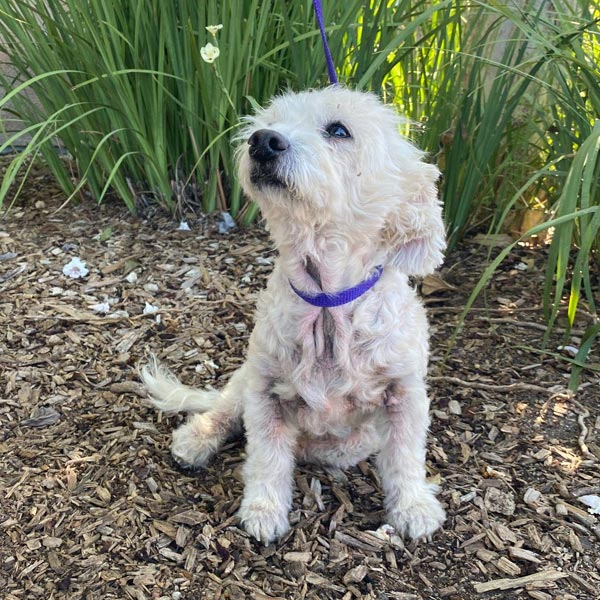
Fluffy came to us with chronic skin issues. While in some cases skin issues can be secondary to various metabolic disease or parasites like mange, but oftentimes they are due to allergies. Dogs and cats have three main types of allergies affecting the skin. Flea allergy dermatitis is an allergy to saliva of a flea and a single flea can cause a big flare up. Food allergies are another large category that can cause skin issues. Last of all is allergies to something in the environment (pollens, dust mites, etc) and is called atopy or atopic dermatitis.
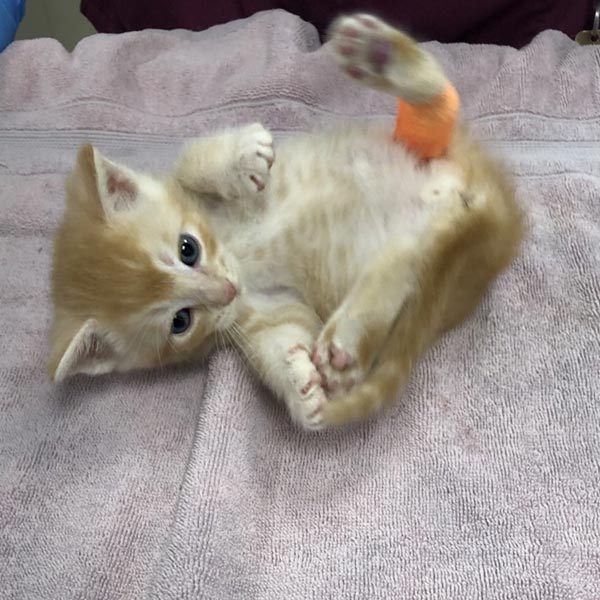
This cute kitten needed a blood draw today and was very dramatic about his pressure wrap that was put on afterwards.
